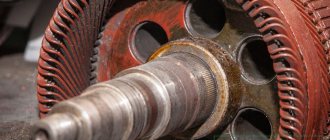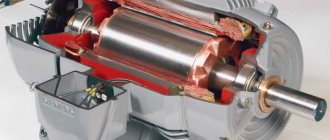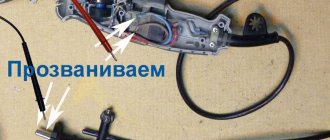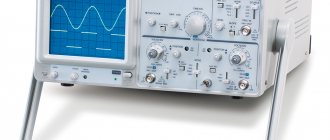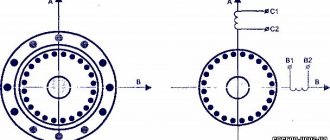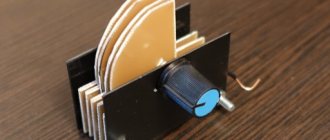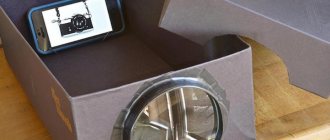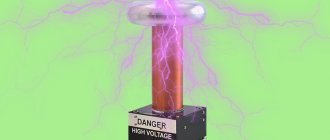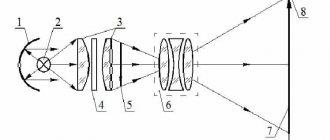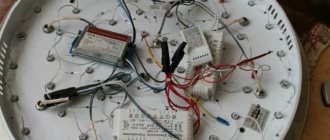Main causes of breakdowns
The most common causes of electric motor breakdowns are improper operation and aging of parts. Electric motor faults are divided into two types: mechanical and electrical.
There is a list of the most common breakdowns that occur with electric motors in various household appliances and appliances.
- Faulty fan. The motor is under acceptable load, but the stator is overheating.
- The rotor touches the stator. In this case, the steel overheats greatly.
- Violation of normal ventilation of the electric motor. The stator winding overheats.
- Intense current pulsation in the stator.
- Poor contact in the rotor chain.
- The fuse overheats, the electric motor does not start.
- Broken stator winding.
- Strong heating of brushes and commutator, sparking.
- Destruction of raceways. Extraneous noise is heard in the bearings.
Increased vibration. May occur due to the rotor and couplings being unbalanced.
Problems with a squirrel-cage rotor
If we talk about the design of the engine, then it consists of a stationary part, which is called the stator, and a rotating part, which is called the rotor. The stator parts include a housing and a special core with a metal winding.
The rotor consists of a core with a winding and a shaft. During operation, the rotor shaft rotates in special bearings, which are located in protective shields. Repairing an asynchronous motor can take anywhere from a few minutes to an hour.
To prevent the engine from overheating, it is cooled by blowing from the outer surface of the housing. The air flow is created by rotating a centrifugal fan, which is covered with a casing so that parts and components from the external environment do not get there. During repair of an asynchronous motor, the casing may open. At the time of repairing engine problems, in order to quickly change the direction of rotation of the rotor, change the speed, and also to reverse the engine, it is necessary to change the direction of rotation of the magnetic field that is created during the operation of the stator winding.
This effect can be achieved by switching two phases, that is, 2 of the 3 wires that connect the stator winding to the electrical network. Thanks to high-quality repair of an asynchronous motor, the device can be returned to normal operation.
Electrical and mechanical faults
Most often, short circuits in the winding, breaks in the winding or external circuit occur.
- The electric motor does not start.
- The windings overheat greatly.
- The rotation speed is not normal.
- Excessive noise – knocking or humming.
- Unequal current in individual phases.
Before you repair the electric motor yourself, you need to understand the cause of the breakdown.
As for mechanics, failures most often occur in the bearings; they can overheat and oil can leak from them. Mechanical damage also includes damage to the housing, breakage of the impeller, engagement of the rotor with the stator, and rotation of the rotor on the shaft.
Emergency situations
There are malfunctions that are not related to the engine, but affect its operation.
The list of emergency situations includes the following items.
- The shaft is subjected to excessive load, in which case the drive and mechanisms jam;
- Supply voltage imbalance occurs due to network problems and internal drive problems;
- A phase may be lost;
- Difficulties with cooling, due to a faulty impeller, a fan stopping or an increase in room temperature;
These damages are caused by mechanical overload or increased current.
Occupational Safety and Health
While working, craftsmen must wear special clothing that will protect them from small parts and possible injuries.
When repairing the rotor of an asynchronous motor, you must be careful not to catch clothing or additional material in the rotating parts. Do not touch live parts or grounded wires on the machine with your hands.
To do this, you need to use special tools that have insulated handles. Otherwise, you need to turn off the engine and only then continue repair work.
When impregnating and drying windings, the impregnated chamber must be equipped in accordance with safety requirements. Smoking and open fire are prohibited in the room where the electric motor is being repaired.
Electric motor repair
Overhauling an electric motor is a complex process, but if a minor breakdown is detected, you can fix it yourself.
The most common breakdowns are not difficult to detect; the main thing is to know how to remove this or that damage.
- If the electric motor does not start, you can replace the fuse or switch; most often they are the ones that fail.
- If current pulsation occurs in the stator, it is necessary to resolder the winding solders.
- If the stator overheats, it is necessary to remove the protective casing from the fan and repair it. Sometimes it is necessary to remove unnecessary elements and burrs on the stator that touch the rotor, causing friction and overheating.
- When a rotor malfunction occurs, the windings are soldered, sometimes it is necessary to replace the liners or adjust the bearing shields.
- When heating the brushes, it is necessary to accurately align the brushes and their holders.
- In case of strong vibration, the rotor, coupling half and pulleys are balanced. It is also necessary to center the electric motor.
If knocking occurs in the bearings, they simply need to be replaced with new ones.
These are the most popular types of electric motor repairs that you can do yourself. Only by determining the exact cause can you return the electric motor to operation again by carrying out competent repairs to the part.
Preparing the machine for repair
A machine that arrives for repair or inspection must be equipped with all necessary parts, cleaned of dirt, and the upper elements must be removed. This will allow you to quickly and efficiently carry out superficial diagnostics and find out the causes of problems.
To measure insulation resistance, a special device is used - a megohmmeter. To carry out a high-quality check of the windings, technicians recommend using a universal resistance bridge or special probes. When overhauling asynchronous motors, it is better to determine the temperature of individual accessible places using shelf-type alcohol thermometers, which are cylindrical in shape and small in size.
This will allow you to use the thermometer in hard-to-reach places and correctly determine the temperature. To avoid damage during inspection, it is recommended to wrap the thermometer reservoir with special foil - this will help press the device more tightly to the heated surface.
The bearing temperature can be much higher if it is damaged or lacks special lubricant. The results of the inspection must be recorded in a protocol or journal.
Motor protection options
There are various devices that provide additional protection for the engine and minimize damage.
- Thermal relays and automatic motors. They reliably protect the electric motor from damage due to excess current.
- Electronic relays. It is a microprocessor that analyzes the voltage value.
- Thermal relays and thermistors. They help avoid breakdowns when the thermal protection does not work due to overheating.
- Frequency converter. It carries several functions related to overload protection.
Advice from the experts
Depending on the type of breakdown, repairs may take a long period of time. If you do not have certain skills in working with electric motors, understanding the circuit diagram of the device itself, or additional parts, it is not recommended to carry out repairs yourself.
If the engine is not operating properly, you can re-diagnosis or correct its elements. A mandatory point of correctly performed work is testing the electrical insulation strength and checking the motor in test mode.
Diagnostics
To understand how to repair an asynchronous electric motor, it is necessary to carry out preliminary diagnostics.
Diagnosis of the causes of malfunctions is the key to successful repairs.
If the breakdown did not occur due to an emergency, then the following actions are performed:
- Visual inspection of the electric motor;
- Measurements of clearances in bearings;
- Measuring basic parameters of an electrical installation;
- Checking the integrity of the brush assembly;
- Detection of overheating and intense heating zones.
Repair of components and parts
Before starting work, it is mandatory to inspect the technological map for repairing an asynchronous motor. Thanks to preliminary diagnostics, the problem and specific malfunction are determined.
A plan is being drawn up to remove it. The main malfunctions include weakening of the pressing, fluffing of the teeth, heating of the core, burnout of individual sections, and deformation of the steel during fast operation. The repair procedure includes diagnosing the spacers and tightening the bolts.
To eliminate weakening of the pressing in the event of individual teeth breaking or falling out, some craftsmen recommend hammering and strengthening special wedges that will do the desired job and not slow down the electric machine. When the core heats up, craftsmen not only remove it, but also completely replace the insulation, since this affects the operation of the coupling bolts. If the insulation begins to break through on the steel winding, complete clearing and winding of new elements is done.
Useful tips for operating an electric motor
- Maintenance, operation control and timely detection of faults.
- Checking the heating temperature.
- If the electric motor has not been running for more than 20 days, you need to check the presence of oil in the bearings and the condition of the driven mechanism.
- It is important to pay attention to the voltage in the electrical network. The voltage must be at least 80% of the rated voltage.
- The grease in the bearings must be loosely packed, otherwise it may cause overheating.
- It is important to pay attention to the insulation of the windings; their damage can lead to engine failure.
- Before installing the electric motor, it is necessary to check that the windings are not shorted to each other.
- The DC commutators should be clean, as should the brushes and slip rings.
Disassembling the machine
The craftsmen begin work by removing the upper casing, which covers the fan blades from dust and contaminants from the outside. The disassembly process must be carried out as carefully as possible to avoid hammer blows or great force. This may damage the motor parts and cause it to malfunction.
During the repair process of a three-phase asynchronous motor, the bearing caps and bearing shields are removed. At the time of disassembling the elements from the shields, marks must be applied to the body, according to which, when reassembling the machine, the shield is installed in the right place.
If the machine is small, then the rotor is removed from the stator manually. When the dimensions are large, the element is removed using special lifts, the process is carried out along the axis of the machine.
When it comes to removing bearings, there are several options. Elements of bushings or liners can be knocked out or protruded from special shields. Efforts cannot damage the main elements.
Photo of electric motor repair
Wound rotor design
The phase rotor of the IM is structurally similar to its stator. The rotor base is made of electrostatic steel plates, which are mounted on the shaft. The design has longitudinal grooves into which the turns of the phase winding coils are placed. The number of rotor phases strictly corresponds to the number of stator phases. To connect the rotor winding to the circuit, 3 slip rings are installed on the latter’s shaft, to which the ends of the winding are connected, which are in contact with the conductive brushes. In turn, the brushes have outlets into the housing box, which will allow you to connect external additional resistance.
Read also: Wood cutters for cutting locks
Depending on the network voltage, the winding phases are connected in a “triangle” or “star”. The axes of the coils of a two-pole electric motor are shifted 120 degrees relative to each other.
Slip rings are made of brass or steel. They are mounted on the shaft with mandatory insulation between each other. The brushes are located on a brush holder, made of metalgraphite, and pressed against the rings by means of springs.
Commissioning
PUE (Electrical Installation Rules) regulate acceptance tests before putting the electric motor into operation (clause 1.8.15). Test programs and the number of devices that will be subjected (from a batch) are established by the standard or specifications for a specific type of engine. The following is checked:
- Possibility of turning on the electric motor without preliminary drying of the windings (for electric motors with a rated voltage of up to 1 kV or more).
- Insulation resistance.
- Checking the stator windings by applying increased power frequency voltage. Each winding is checked separately (with the other two connected to the housing). If there are no leads from the coils, then it is possible to check the winding completely.
- Measuring the resistance of windings to direct current. To identify poor-quality connections, interturn short circuits, and errors in the connection diagram. Also for removing parameters necessary for calculating modes, transitions and controllers.
- The electric motor is idling (the drive mechanism is not loaded).
- Operation of the electric motor under load.
Expert opinion
It-Technology, Electrical power and electronics specialist
Ask questions to the “Specialist for modernization of energy generation systems”
5 The procedure for disassembling an asynchronous motor with a squirrel-cage rotor is to remove the rotor from the frame, having previously laid a press sheet, 0.5 - 1.5 mm thick, between the rotor and stator to protect the windings from scratches and damage; Ask, I'm in touch!
Standards for testing electrical machines after repair (according to PEEP)
Random stator windings
AC motor element under test with Un≤0.66 kV
Test voltage, kV depending on power Pn, kW
Windings after laying in the grooves before soldering the intercoil connections
Windings after soldering and insulating intercoil connections
Windings after impregnation and pressing of the wound core
Main winding insulation of assembled AC motor
Rectangular wire stator windings
Rotor windings
The remainder of the winding after removing the replacement coils, sections or bars
The entire winding after attaching new coils, sections or rods
What kind of lighting do you prefer?
Built-in Chandelier
* 2U*rot - voltage on the rings of a stationary rotor with an open winding at the rated voltage on the stator.
Permissible air gap values
PBD wire with single layer paper tape insulation
Wire with single-layer insulation with mica tape 0.13 mm thick with full overlap
PBB wire with single-layer silk varnish insulation 0.1 mm thick with full overlap
PBD and PDA wires with single-layer insulation with mica tape 0.13 mm thick with a full overlap or 1/3 overlap
PBB or PDA wire with single-layer insulation with mica tape 0.13 mm thick, completely overlapped and topped with a layer of cotton tape end-to-end
PDA wire, insulated with two layers of mycalente 0.13 mm thick, completely overlapping
An asynchronous electric motor is designed to convert electrical energy into mechanical energy, which is necessary to drive mechanisms used in a wide variety of industries, agriculture, everyday life, etc.
The main parts of an asynchronous machine are the stator and rotor, separated by an air gap. The active parts of the electric motor are the windings and the magnetic circuit. The remaining structural parts give the electric motor strength, rigidity, cooling (fans are used for this), and the ability to rotate (bearings).
The stator winding is three-phase. The phases are connected according to “triangle” or “star” circuits.
According to the rotor design, there are two types of electric motors:
In electric motors with a squirrel-cage rotor, only the stators can be repaired.
Often it is necessary to perform mechanical work on the rotor shaft - restore bearing seats or fill holes in covers.
Features of overhaul of an asynchronous electric motor with a wound rotor.
The wound rotor has a three-phase winding connected in a star configuration. The winding is brought out onto slip rings that rotate with the machine shaft. Based on this, the design of an electric motor with a wound rotor includes brush mechanisms with brush holders and metal-graphite brushes sliding along slip rings.
In this regard, very often during major repairs, not only the stator winding is rewound, but also the rotor. In this case, very often there is a need to repair or completely replace the brush mechanism.
Specialists of Elpromtekhcenter LLC perform all this work. In addition, we carry out repair work on elevator electric motors, which also belong to the asynchronous category.
Overhaul of asynchronous electric motors with random winding requires rewinding the stator. The technology for repairing such an engine, if the winding is burned out, does not provide for replacing only part of the sections.
After complete disassembly of the engine and removal of the rotor, diagnostics (defects) are performed - the presence of a turn or housing short circuit, the condition of the rotor shaft, the condition of the bearings and their seats on the rotor shaft are checked. Replacement of Russian-made bearings is included in the cost of work, which is reflected in the price list.
The presence of the necessary equipment in our company allows us to wind compact and high-quality sections, which our specialists then place in the slots of the electric motor stator.
Impregnation of windings with varnish, oven drying, and painting of the electric motor are mandatory components of their overhaul in our company.
We approach electric motor testing with great responsibility. For this we have all the necessary instruments on the test bench.
As a rule, the warranty on our work is 6 months.
- Electric motor defective.
- Rewinding the stator winding.
- Replacing stator lead ends.
- Replacement of bearings (the cost of domestic ones is already included in the cost of repairs, for the use of foreign ones you have to pay the difference).
- Repair of bearing seats - additionally if necessary.
- Impregnation of the stator winding, drying.
- Electric motor testing.
- Painting the electric motor.
Expert opinion
It-Technology, Electrical power and electronics specialist
Ask questions to the “Specialist for modernization of energy generation systems”
Repair of asynchronous electric motors During the repair process, operational tests and operational control are carried out, the purpose of which is to identify errors, low-quality materials or spare parts and timely elimination of identified defects. Ask, I'm in touch!
Commutator grinding process
The process of grinding the collector must begin with the selection of sanding material. It is recommended to use sanding paper or a file to sand the commutator.
Choose several sizes of sanding paper, starting from #100 and above.
Now start sanding. Applying a wooden block with sandpaper attached to the commutator, rotate the drill and, without pressing the block too hard to the surface of the commutator, grind.
Grinding the commutator in a drill
It is recommended to use the grinding operation on already operating rotors with minor wear on the commutator.
Proper brush sparking
If you have replaced the commutator on the rotor of the Makita 2470 rotary hammer, then after installing it on the shaft, the commutator must be machined. This operation is performed to eliminate radial runout of the surface of the lamellas of the new collector relative to the armature shaft.
It is best to grind the manifold on a lathe using mandrels. But this operation can also be performed at home. True, you can’t do it without an additional device. The video will help you understand the manifold groove.
As a rule, brush holders on hammer drills are mounted opposite each other. Prolonged operation of the brushes leads to the formation of grooves on the collector, creating waviness on the surface. Such wear can only be eliminated on a lathe by turning the commutator.
To reduce the formation of grooves on the commutator, you should try to arrange the brush holders in a checkerboard pattern.
How to clean the slots of a rotary hammer manifold
But the grooves between the lamellas must be cleaned, since micanite, the material of the gaskets between the lamellas, is harder than copper lamellas and wears out less. Over time, micanite spacers wear less, and their height exceeds the height of copper lamellas.
To equalize the heights, the grooves between the lamellas are milled, or, in simple terms, resurfaced.
Do-it-yourself milling is best done with a piece of metal saw sharpened to the width of the collector grooves.
Milling grooves by hand
A metal ruler is applied parallel to the edge of the groove, the saw is pressed against its edge and pulled out with gentle pressure. The groove is milled to the height of the copper lamella.
Milling of grooves ends by removing the remaining material using a hair brush and chamfering using a scraper made from a needle file. It is better to sand with felt.
Any milling should be completed by grinding and blowing air.
The level of collector output is also affected by the condition of the bearings. Worn bearings lead to increased commutator runout, which in turn leads to accelerated wear of the carbon brushes. To eliminate collector runout, it is recommended to replace suspicious bearings with new ones.
